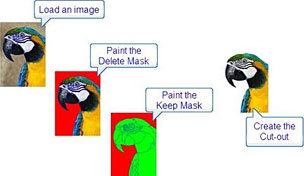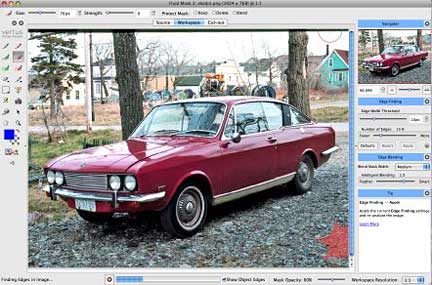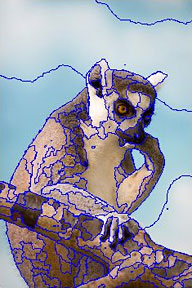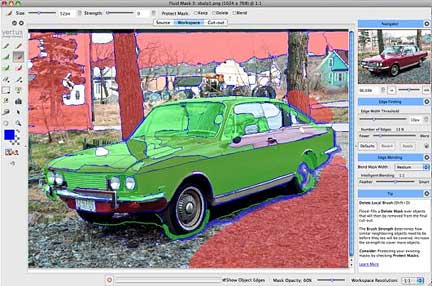Miscellaneous Ramblings
Miscellaneous Ramblings Review
Vertus Fluid Mask 3: A Powerful Image Masking Tool for Cleaning Up Image Backgrounds
Charles Moore - 2009.03.30 - Tip Jar
Rating: 
Last week we examined Vertus Software's Bling It! software, an inexpensive image-enhancement program designed to help non-expert graphics users, even amateurs, transform their digital photos into professional-looking images of items or products for publishing on the Web or on online auction sites, like eBay and Craigslist.
Bling It! uses technology borrowed from Vertus' Fluid Mask 3.0 standalone masking/cutout application and plugin for Adobe Photoshop CS and Photoshop Elements - a program intended mainly for use by professional and advanced amateur photographers, graphic artists, designers, picture editors, and anyone else who takes digital image editing seriously.
As with Bling! It, Fluid Mask's main purpose is "masking," to separate and extract or "cutout" portions of digital images from their backgrounds, which is accomplished by painting over unwanted areas of images using the program's selection of tools and then clearing the paint-designated areas with a mouse-click.
While cutouts can be accomplished by skilled Photoshop (or other graphics program) users with a degree of painstaking tedium and difficulty, Fluid Mask's mission is to make the task faster and less boring, as well as less demanding of user skill. However, there is still a learning curve to be scaled, before one becomes proficient in getting the best from this program, especially when it is applied to manipulating complex images.
As noted, Fluid Mask can be used as a standalone application, as a plugin to Photoshop (CS2, CS3), or Elements 6 launched from those applications' Filters menu (see Appendix at the end of this article for setup instructions for using Fluid Mask with Elements). I tried it both ways; on its own and with Photoshop Elements 6. In either case, Fluid Mask works pretty much the same way, and with the same interface, although the standalone mode is considerably more selective about what image formats it can open and save independently. The program prefers RAW images, is reasonably happy with PNGs, and can work with JPEGs, although in some instances less successfully due to the JPEG format's "lossy" nature.
 Fluid Mask streamlines and simplifies the task of cutting out
images in two ways:
Fluid Mask streamlines and simplifies the task of cutting out
images in two ways:
- Fast masking tools - combined with image analysis, the Fluid Mask tools allow you to quickly mask even complex cutouts.
- Intelligent blending - Fluid Mask uses the characteristics of the edges between image objects to calculate the optimum blend between them. Sharp edges remain sharp. Transparent and blurred edges are feathered across their widths and background colors are removed (something not easily achieved when making cutouts manually with image editing applications).
To edit an image in Fluid Mask, open it by using the program's Open dialog or just drag your image file to the program's icon in the Dock, and then paint masks over your image to indicate which parts to keep and which part to remove. Fluid Mask uses three types of mask:
- Keep mask: indicates the part of the image to retain - the green-colored tools
- Delete mask: indicates the part of the image to remove - the red colored tools
- Blend mask: indicates the border of the cutout across which Fluid Mask will create a blended transition - the blue-colored tools
As test image I decided to use this photo of a car, to remove the subject from its busy and somewhat unphotogenic background.

This is the image we started with.
When you open an image, Fluid Mask automatically analyzes it to identify the distinct areas of color and texture within the image, and then "maps" it with edges.

Progress bar lets you know how Fluid Mask is coming along.
There is a progress bar at the bottom of the Fluid Mask window in which you can track lengthy operations such as image analysis. If required, you can also cancel an operation using the Cancel button.
 Note that Vertus cites minimum system requirements of an
833 MHz G4 or better with at least 512 MB of RAM. However, using the
program for this review on my 1.33 GHz PowerBook G4
with 1.5 GB of RAM, I found it none-too-swift doing the image analysis
and edge map drawing phases and updates. The program is definitely
usable on my G4, but I don't think I would want to use Fluid Mask on a
much slower machine, and I expect it will be a lot happier and more
lively on an Intel Mac. I haven't yet had the opportunity to try it on
my 2.0 GHz MacBook.
Note that Vertus cites minimum system requirements of an
833 MHz G4 or better with at least 512 MB of RAM. However, using the
program for this review on my 1.33 GHz PowerBook G4
with 1.5 GB of RAM, I found it none-too-swift doing the image analysis
and edge map drawing phases and updates. The program is definitely
usable on my G4, but I don't think I would want to use Fluid Mask on a
much slower machine, and I expect it will be a lot happier and more
lively on an Intel Mac. I haven't yet had the opportunity to try it on
my 2.0 GHz MacBook.
When Fluid Mask's image analysis is finished, the edges of the "objects" found will be overlaid as blue outlines on the image, as shown in the example above. You can now use these objects as guidelines to flood-fill the areas you want to keep and those you want to delete. You can also check or uncheck Show Object Edges at the bottom of the Fluid Mask window to hide or reveal the edges of the objects, and adjust the Edge Finding options to address a variety of potential issues. As a last resort, you can also you can use the use the patch tools to apply different Edge Finding options to just a part of an image, or the Force Edge tool to draw a line manually, but smart blending cannot be used with forced edges.
Once the edge configurations have been dealt with you can begin to create an image mask. Select a brush from the Tool Palette and start painting (i.e. filling "objects"). Use the green Keep tools to paint the parts of the image you want to keep. Use the red Delete tools to paint the parts of the image you want to remove, while the blue tools can be used to create a special mask for blending the border of the cutout. You can adjust brush strength and brush size as required to mask your image quickly and efficiently. Fluid Mask has unlimited undos so you can recover easily if your mask flows into the wrong areas.

Selecting which areas to keep, delete, and blend.
There are three brushes for each type of mask:
- Exact brushes mask only pixels touched directly by your brushstroke (like a traditional paint brush).
- Local brushes work like a combination of a traditional paint brush and a paint bucket tool. Every image object that includes any pixels under your brush stroke will be flood-filled. If you turn the brush strength above the minimum, neighboring objects that are similar in color and texture will also be filled. When using the local brush, paint a stroke through the segments you want masked. Any segments touched will be flood-filled.
- Global brushes work much like the local brushes, except they will fill similar objects anywhere in your image (when the strength is above the minimum).
When using either local or global brushes, you can control the extent of the flood-fill of neighboring objects using the Strength setting at the top of the window. At minimum strength, only those objects touched by the brush will be filled. At maximum strength, large areas of the image can be masked in a single stroke. You can use the Undo function (Ctrl-Z) when experimenting with the brush strength.
Using the Exact brushes is a bit tedious, but the payoff is precision results. However, it all gets a a bit magical when you start using the Local and Global brushes, and the process speeds up immensely.

The final image after removing unwanted details.
When you have finished masking the image, click the Create Cutout button on the Tool Palette (Ctrl-U), and the cutout will be displayed in the Cutout view. You can then zoom in and pan around the image to inspect the edges. You can adjust the background color to make sure the blended edges will look good against your cutout's intended background and return to the Workspace view to touch up the masking. IMHO, it would be a lot more convenient to be able to use some image editing tools in the Cutout View, especially the eraser tool for touching up, but you can use the Preview Cutout tool to check selected cutout areas of your image while still in the Workspace view.
Cutout problems generally result from an edge problem or a blending problem. Edge problems can often be fixed by adjusting the Edge Finding options, while blending problems can be fixed by adjusting the Edge Blending options or touching up the blend masks. The blend mask blends the border between the Keep and Delete masks. Fluid Mask uses the characteristics of the edge between two image objects to produce an optimal border. If the edge is sharp, the resulting border will be sharp. If the edge is soft, the border will be blended across the width of the original transition. You can paint a thinner blend mask to produce a thinner blend on the border of the cutout.

For complex things like wispy hair, you need to use more blending.
When working with complex and challenging cutouts, you may need to use some of Fluid Mask's more sophisticated mask editing power. For example, images with areas of wispy hair or animal fur through which the background can be seen need to be masked with liberal amounts of blending.
Other tricky image contents that Fluid mask can help you work around are ones containing lattice-like structures or tree limbs, or ones in which areas of background and foreground intermix. While going into detail about tools and techniques one can use in Fluid Mask to deal with these tricky sorts of images when making cutouts is beyond the scope of this review, the value of this program is accentuated in its ability to tackle them.

Happily, the Fluid Mask manual, which can be downloaded from the Vertus Website, is very thorough and helpful in walking you through both the basics and not-so-basics of using the program.
 When you are
satisfied with the cutout displayed in the Cutout view, if you're are
using Fluid Mask as a plugin, select Save and Apply from the File menu,
and your cutout will replace the contents of the layer active when you
started Fluid Mask. If you're using Fluid Mask standalone. select Save
(Ctrl-S) or Save As from the File menu. Fluid Mask can save in either
PNG or TIFF image file formats, or if you're using it in plugin mode
with Photoshop in many other formats.
When you are
satisfied with the cutout displayed in the Cutout view, if you're are
using Fluid Mask as a plugin, select Save and Apply from the File menu,
and your cutout will replace the contents of the layer active when you
started Fluid Mask. If you're using Fluid Mask standalone. select Save
(Ctrl-S) or Save As from the File menu. Fluid Mask can save in either
PNG or TIFF image file formats, or if you're using it in plugin mode
with Photoshop in many other formats.
To summarize, Fluid Mask 3 is a powerful tool that can save you a ton of time if you work with image cutouts a lot, so as with the substantial cost of say, Photoshop CS, Fluid Mask's price of $149 (recently reduced almost 40% from its original cost of $239) will be repaid many times over through increased work efficiency. It can be a very useful tool for nonprofessionals as well, but if you only work with cutouts occasionally and casually, you might want to check out Vertus' Bling It! application, which also does cutouts, for a more modest price of $29.95. Both programs are available as 30-day demos, so you can try them both out and compare how well they respectively meet your needs before committing any money.
Low End Mac rating: 3.5 out of 4
A fully functional free trial of Fluid Mask 3 is available for immediate download.
System Requirements
Adobe Photoshop or Photoshop Elements (when using Fluid Mask as a plugin)
Minimum OS requirements:
- Mac OS X 10.2.8 or higher
- 833 MHz G4 or higher
Windows
- Windows 2000, XP or above
- Processor speed 750 MHz or higher
- 512 MB RAM
- CD-ROM drive
- SVGA monitor with 24-bit color display
- Internet connection
Appendix: Setup Instructions for Fluid Mask with Photoshop Elements
Fluid Mask 3 will work in Adobe Photoshop Elements 6, but the product files require manually loading.
To install Fluid Mask into Elements these instructions:
- Double click the Fluid Mask file to start the installation process.
- During installation, you'll come to a page where you have to "Choose Photoshop Versions". On that page, select "Other".
- Click "Next".
- You will be asked for the Photoshop Plug-Ins folder in which to install Fluid Mask. This is typically:
[your home directory] > Adobe/Photoshop Elements/Plug-Ins
or
[your home directory] > Adobe/Photoshop Elements/Plug-Ins/Filters
Choose the appropriate folder and then continue with installation as normal.
Join us on Facebook, follow us on Twitter or Google+, or subscribe to our RSS news feed
Charles Moore has been a freelance journalist since 1987 and began writing for Mac websites in May 1998. His The Road Warrior column was a regular feature on MacOpinion, he is news editor at Applelinks.com and a columnist at MacPrices.net. If you find his articles helpful, please consider making a donation to his tip jar.
Links for the Day
- Mac of the Day: Motorola StarMax 3000, introduced 1999.09.07. This inexpensive clone used lots of off-the-shelf parts.
- Support Low End Mac
Recent Content
About LEM Support Usage Privacy Contact
Follow Low End Mac on Twitter
Join Low End Mac on Facebook
Favorite Sites
MacSurfer
Cult of Mac
Shrine of Apple
MacInTouch
MyAppleMenu
InfoMac
The Mac Observer
Accelerate Your Mac
RetroMacCast
The Vintage Mac Museum
Deal Brothers
DealMac
Mac2Sell
Mac Driver Museum
JAG's House
System 6 Heaven
System 7 Today
the pickle's Low-End Mac FAQ
Affiliates
Amazon.com
The iTunes Store
PC Connection Express
Macgo Blu-ray Player
Parallels Desktop for Mac
eBay

